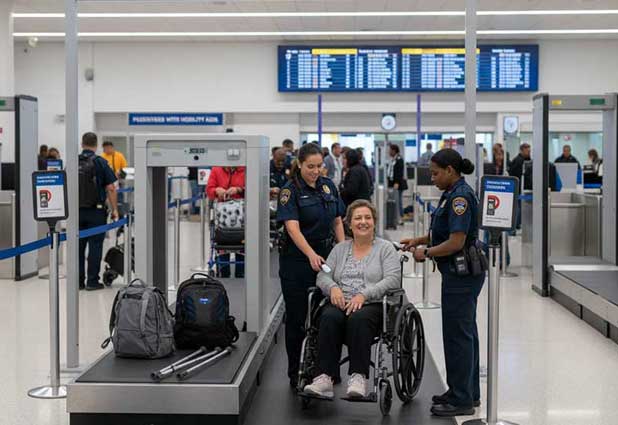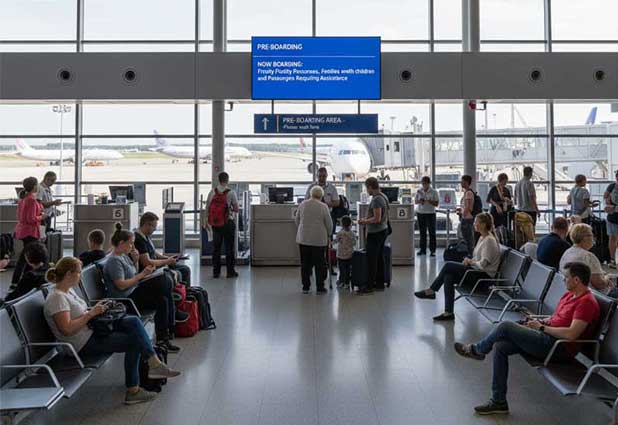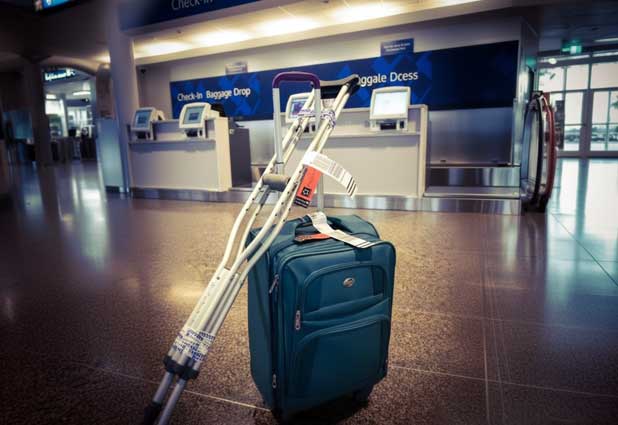Table of Contents
Quick summary
Yes, you can fly with crutches
- Crutches are always allowed through TSA checkpoints and on commercial flights.
- You have the right to pre-board, store crutches for free, and request wheelchair service.
- The Air Carrier Access Act protects you from discrimination and guarantees reasonable accommodations.
Know your rights
The Air Carrier Access Act (ACAA) requires U.S. airlines (and foreign carriers flying to or from the United States) to accommodate passengers with mobility aids. Print or save this mini checklist for gate conversations:
Protected rights
- Pre-board whenever you need extra time or space.
- Store crutches for free in the cabin or gate-check them without fees.
- Request wheelchair assistance from curb to seat and during connections.
- Ask for an aisle seat with a movable armrest if available.
- Travel with one companion during pre-boarding when needed.
Reference: U.S. DOT – passengers with disabilities
If an airline refuses pre-boarding, damages your crutches, or denies basic assistance, file a complaint directly with the airline and, if they do not resolve it, escalate to the DOT’s Aviation Consumer Protection office.
Seat selection strategy
Aisle seats near the front or close to a lavatory shorten every transfer and make it easier to stand without climbing over strangers. Exit rows and even some bulkhead seats sound roomy, but they restrict where you can store crutches and often require passengers to meet extra safety rules, which is the last thing you need mid recovery. If you are unsure where to sit, call the airline’s disability or special assistance desk (not just the general phone tree) and ask which rows offer movable armrests or easier access.
International flights
Flying outside the United States? The EU, UK, Canada, and many other regions have similar accessibility laws, but the exact protections and complaint processes differ. Look up your airline’s “special assistance” page and read the local passenger rights document for disabled travelers before you go so you know who to contact if something goes sideways.
TSA screening step-by-step

TSA officers screen thousands of travelers with crutches every week. Arrive early (90 minutes domestic, two hours international) and follow this proven flow:
- Tell the officer you are using crutches. They will explain the process and flag a secondary lane if needed.
- Choose screening style. You can walk through the metal detector with crutches, use a full-body scanner, or request a pat-down instead.
- Crutch inspection. Crutches are visually checked and swabbed for explosive residue, usually 30–60 seconds.
- Personal screening. Walk through the detector slowly. If alarms sound, expect a short pat-down of the area that triggered it.
- Collect your gear. Officers can help you gather items so you do not lose balance.
TSA PreCheck perks
If you have TSA PreCheck you can usually keep shoes and jackets on. The crutch inspection still happens, but the line is faster and less crowded.
You can request a private screening room or officer assistance at any time. If you have questions in advance, call TSA Cares at 855-787-2227 at least 72 hours before your flight.
Pre-boarding and storing crutches

Pre-boarding lets you move without a crowded aisle and guarantees overhead space near your seat. Tell the gate agent, “I’m using crutches and would like to pre-board.” No doctor’s note required.
| Airline | Pre-boarding policy | Companion allowed? | Contact |
|---|---|---|---|
| American | Pre-board before Group 1 for mobility aids | Yes, one person | 800-433-7300 |
| Delta | Extra-time boarding before general groups | Yes | 404-209-3434 |
| United | Board before Group 1 | Yes | 800-228-2744 |
| Southwest | Pre-board before A group | Yes | 800-435-9792 |
| JetBlue | Early boarding for anyone needing assistance | Yes | 800-538-2583 |
| Alaska | Pre-board before Group A | Yes | 800-503-0101 |
Storage options:
- Overhead bin: Place crutches diagonally above your seat. Ask for help lifting them.
- Coat closet: Available in many first/business cabins.
- Under-seat: Works only for forearm or folding crutches.
- Gate-check: If bins are full, the crew tags them for cargo and returns them at the jet bridge.
Safety reminder
Crutches cannot block the aisle or sit in exit rows during takeoff and landing. Crew members ensure safe storage, so hand them over if asked.
During the flight: pain and swelling management
Once you are seated, comfort becomes all about positioning and timing. These habits made long flights bearable for my injured ankle:
- Prop the injured leg. Ask for a spare pillow or folded blanket so you can elevate your foot slightly above hip level. Even two inches helps calm throbbing after takeoff.
- Coordinate pain medication. Talk with your doctor before travel about when to take prescription or OTC meds so they peak during boarding and landing, which are always the most stressful moments.
- Tiny movements keep blood flowing. If your provider allows it, perform gentle ankle circles, wiggle toes inside the boot, squeeze your quads or glutes, and take deep belly breaths every 20–30 minutes. They fit within non-weight-bearing rules yet fight stiffness.
- Consider compression socks. Ask your doctor whether light compression (15–20 mmHg) is appropriate for your injury and circulation history. They dramatically reduced swelling for me on flights longer than two hours.
- Stay hydrated. Dehydration makes swelling worse. Bring a reusable water bottle and refill it after security so you are not relying on infrequent drink service.
If pain spikes mid-flight, let the crew know. They can grab ice packs, move your seatmate temporarily so you can stretch, or alert medical personnel if something feels off.
Bathroom logistics
Ask the gate agent or crew whether an aisle chair is on board. Flight attendants can steady the chair and provide privacy but cannot lift you, so plan ahead. On short flights, use the airport restroom right before boarding if the cabin lavatory will be hard to access with your current setup.
Wheelchair assistance

Wheelchair escorts are free under federal law. Use them when you have long walks, terminal changes, or limited energy.
- Request when booking (online checkbox or phone call) or at least 48 hours before departure.
- Check-in. Remind the agent you requested a chair or ask curbside if you did not do it in advance.
- Connections. Tell the flight attendant before landing so an escort meets you at the jet bridge.
- Arrivals. The assistant can take you to baggage claim, connecting gates, or curb transportation.
Pro tip
Large hubs (ATL, DFW, DEN) can have 10–20 minute waits for wheelchairs during peak times. Build in extra time or request the service when you buy your ticket so you are prioritized.
Handling connections

Tight connections are stressful even without crutches. Aim for:
- 60 minutes minimum for domestic same-terminal transfers.
- 90 minutes if you must change terminals or ride a train.
- 2–3 hours for international connections where you clear customs.
If you miss your connection because of mobility delays, call the airline immediately; most will rebook you without fees. Document any service failures (wheelchair no-shows, denial of assistance) so you can file complaints with the DOT if needed.
Pre-flight checklist
Before you leave home
- Notify the airline and add wheelchair service if you think you might need it.
- Request an aisle seat with a movable armrest.
- Add extra padding or gel covers to your crutch grips.
- Pack prescriptions and pain meds in your carry-on.
- Toss spare crutch tips or rubber caps into your bag in case yours wear down mid-trip.
- Carry a small roll of athletic tape or Velcro straps to tighten grips or padding on the fly.
- Bring a simple doctor’s note listing your weight-bearing status and medications so awkward questions at foreign airports are easier to handle.
- Pack a lightweight sling, scarf, or wrap to support your leg if letting it hang gets uncomfortable.
- Download airline + airport apps for maps and gate updates.
At the airport
- Use online check-in and curbside bag drop to minimize walking.
- Look for elevators, moving walkways, and quiet seating near your gate.
- Ask TSA or airline staff for help anytime balance feels sketchy.
- Keep snacks and water in a small backpack so your hands stay free.
Common challenges & quick fixes
- Long security lines: Ask an officer if you can use the disability or TSA PreCheck lane.
- Narrow aisles: Pre-board so you can take your time and walk sideways with crutches together.
- Overhead bins are full: Request the crew to use a coat closet or gate-check tag.
- Missed connection: Call the airline immediately and explain the mobility delay. Ask to be rebooked and request wheelchair service for the next leg.
- Crutches damaged: Report it before leaving the airport so the airline can repair or replace them.
- Lavatory feels impossible to reach: Ask if an aisle chair is on board and plan a single bathroom trip during a quieter moment rather than waiting until turbulence or meal service.
Resources & contacts
Save these numbers to your phone before you travel:
- TSA Cares: 855-787-2227
- DOT Disability Hotline: 800-778-4838
- American Airlines disability desk: 800-433-7300
- Delta: 404-209-3434
- United: 800-228-2744
- Southwest: 800-435-9792
Useful apps: GateGuru (terminal maps), Wheelmap (accessibility info), Flush (accessible restroom finder). If you are flying outside the United States, bookmark your destination’s civil aviation authority or passenger rights office so you know who to call if problems pop up.
Ground transport after landing
The trip is not over until you reach your hotel or home. Book accessible shuttles, taxis, or rideshare services in advance whenever possible, especially if you need space for a wheelchair or knee scooter. Ask your wheelchair escort to take you all the way to the rideshare or shuttle pickup zone rather than leaving you at baggage claim, because most attendants are happy to go the extra distance. Watch for surprise stairs in parking garages and hotel shuttles; a quick phone call before you land can prevent awkward scrambles with heavy bags.
FAQ
No. U.S. airlines do not require documentation, but an optional note helps on international trips or if you carry prescription meds.
Yes. Treat them as mobility aids, not carry-ons. Use overhead bins, the coat closet, or under-seat storage. If space runs out, gate-checking is free.
Arrive at the gate when boarding begins, walk up, and request pre-boarding because you are using crutches. Agents will call you before Group 1.
Yes. The Air Carrier Access Act requires airlines and airports to provide it without charge. Tipping is optional but appreciated.
Report damage immediately before leaving the airport. Airlines must repair or replace mobility aids. Photos and receipts help if you need reimbursement.
Final thoughts
Millions of travelers clear TSA and fly safely with crutches every year. When you know your rights, speak up early, and ask for help before you run out of energy, airports feel predictable instead of chaotic.
Keep advocating for yourself, pack a small stash of patience, and remember that every airline employee, from TSA to gate agents, has procedures for assisting mobility-aid users. You are not inconveniencing anyone by requesting what the law already grants you.
Ready for more travel help?
Pair this airport strategy with our favorite gear and planning guides.
